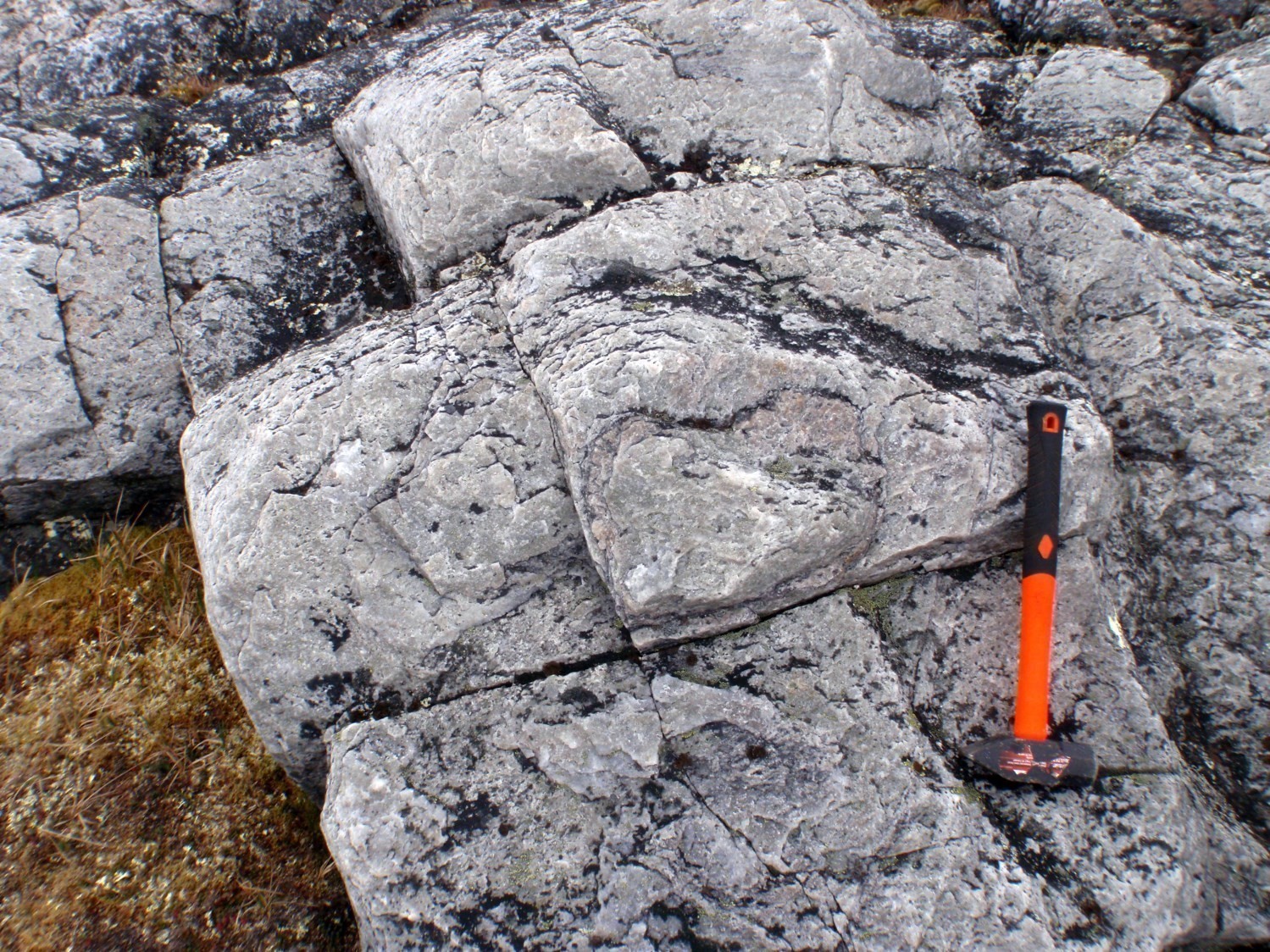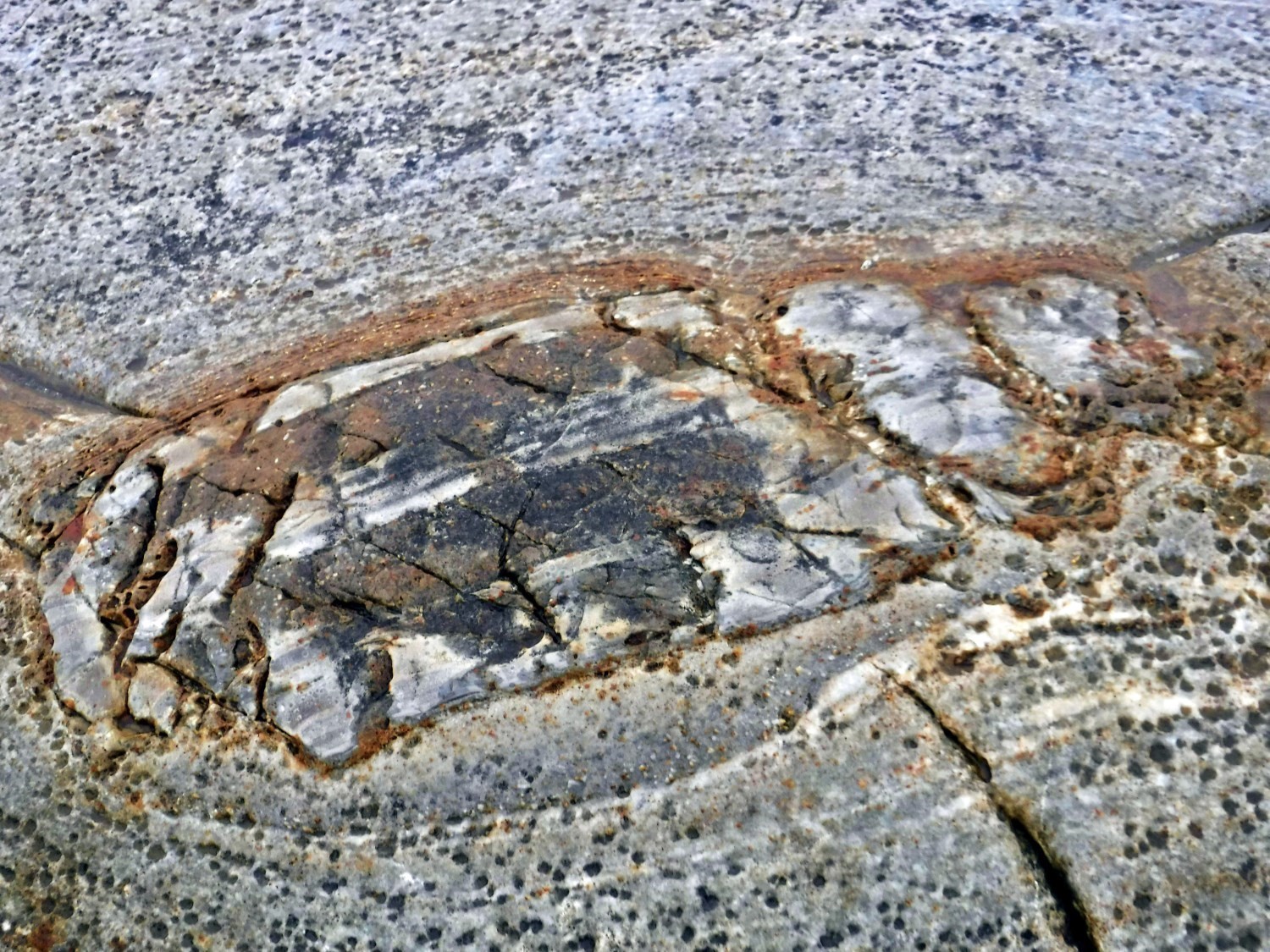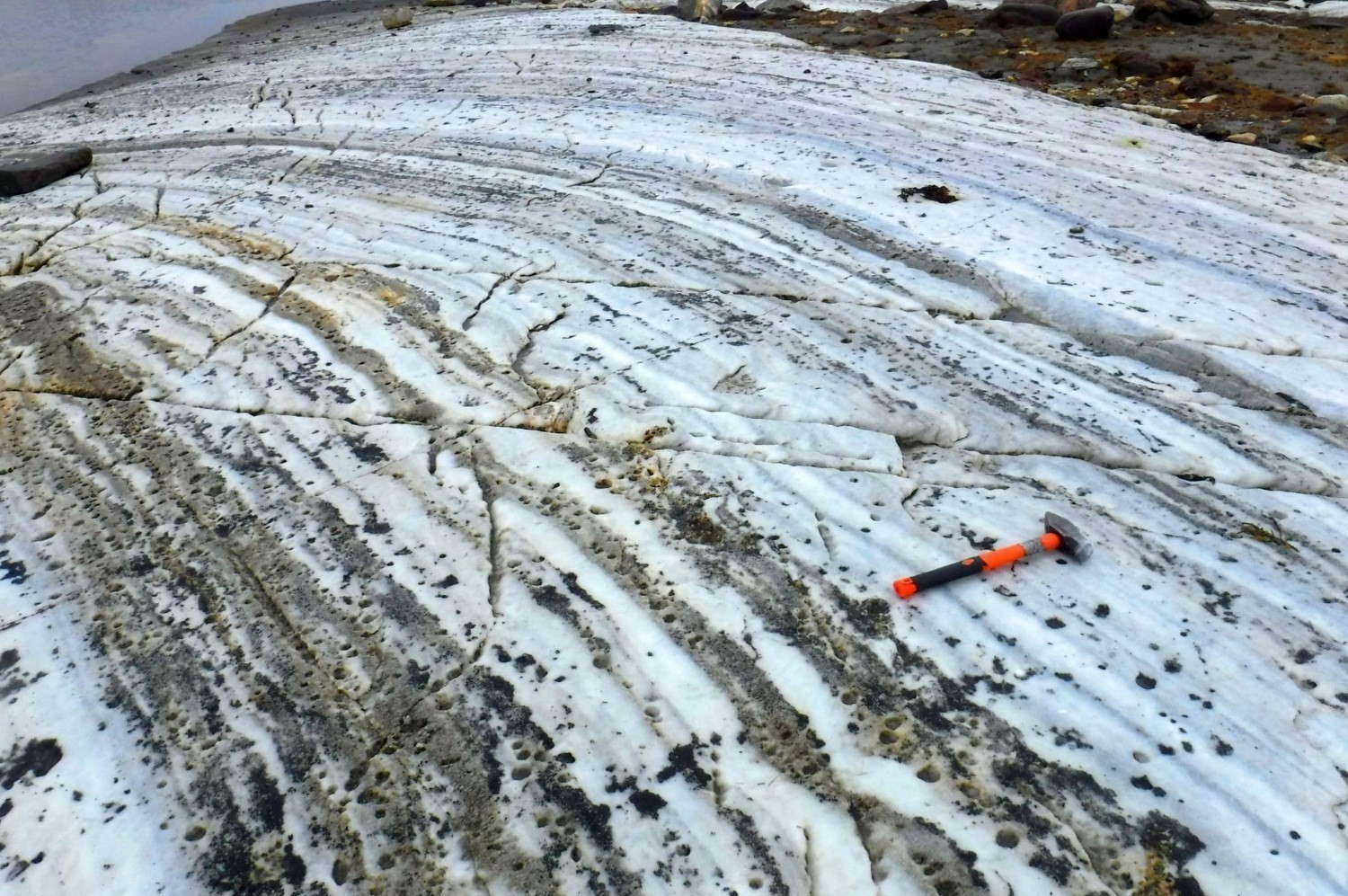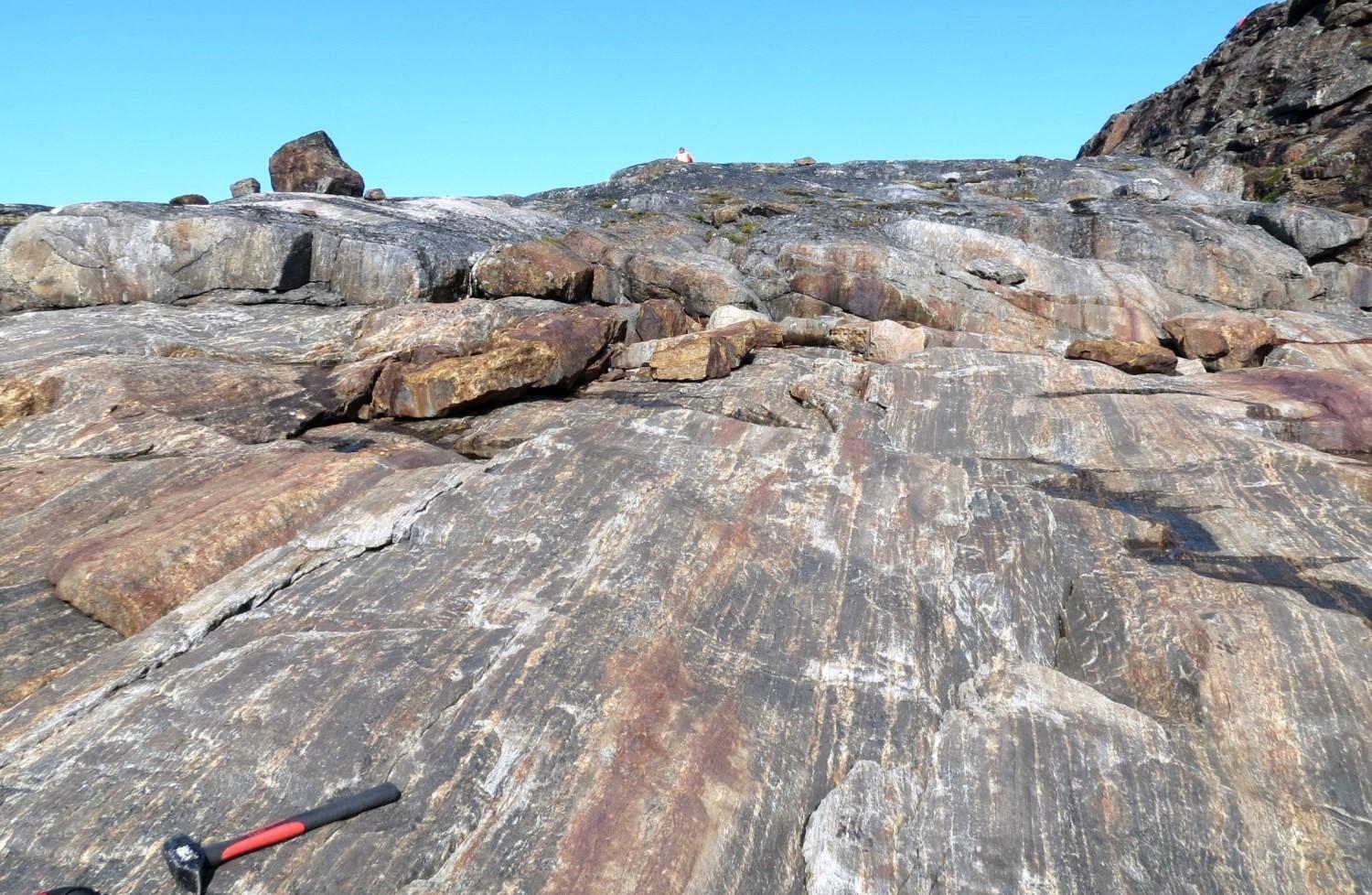
Last modified: 7 October 2022
Translation of original French
| Author(s): | Jackson and Taylor, 1972 |
| Age: | Paleoproterozoic |
| Stratotype: | None |
| Type area: | Baffin Island, Nunavut and Koroc River area (NTS sheet 24I) |
| Geological province: | Churchill Province |
| Geological subdivision: | Falcoz Lithotectonic Domain |
| Lithology: | Volcano-sedimentary rocks |
| Category: | Lithodemic |
| Rank: | Suite |
| Status: | Formal |
| Use: | Active |
None
Background
The Paleoproterozoic volcano-sedimentary rock sequences of the Lake Harbour Suite were described by Davison in 1959 on southern Baffin Island. These sequences were extended into NE Québec and Labrador (« Dorset fold belt ») and introduced as a group by Jackson and Taylor (1972). Taylor (1979) took up the term, but reduced the unit to the rank of formation in order, in his view, to comply with the North American Stratigraphic Code (NACSN, 1983, 2005). Hoffman (1988) did, however, use the informal term “Koroc River sediments” while acknowledging its similarity to the Lake Harbour Group. For priority reasons, Verpaelst et al. (2000) and Simard et al. (2013) maintained the term Lake Harbour Group in the Koroc River and Kuujjuaq areas. Although the correlation with Baffin Island units remains uncertain, Lafrance et al. (2015, 2016) and Mathieu et al. (2018) also assigned volcano-sedimentary rock sequences located in the Falcoz Lithotectonic Domain to the Lake Harbour Group to provide some continuity with the units recognized further north.
Given the degree of metamorphism and loss of primary structures, the use of the term group is inappropriate. Hence, the unit was renamed « Lake Harbour Suite » by Lafrance and Vanier (2022) as part of a synthesis of the southeastern Churchill Province (SEPC; Lafrance et al., 2018) to follow the nomenclature of the North American Stratigraphic Code (NACSN, 1983, 2005). Lafrance and Vanier (2022) also reassigned the metasedimentary rock units located east of the Blumath Shear Zone (ZCblm) and previously included in the Sukaliuk Complex to the Lake Harbour Suite. These changes in nomenclature are detailed in the table below.
|
Revised Units and Subunits (Lafrance and Vanier, 2022) |
Previous Units and Subunits |
References(s) |
|
pPhb1 |
pPhb1 |
Verpaelst et al., 2000; Simard et al., 2013; Lafrance et al., 2015 and 2016; Mathieu et al., 2018 |
|
pPhb1a |
pPhb1a |
Lafrance et al., 2015 and 2016 |
|
pPhb1b |
ApPsuk4 |
Lafrance et al., 2015 and 2016 |
|
ApPsuk4a |
Mathieu et al., 2018 |
|
|
pPhb2 |
pPhb2 |
Verpaelst et al., 2000; Lafrance et al., 2016; Mathieu et al., 2018 |
|
pPhb2a |
ApPsuk5 |
Verpaelst et al., 2000 |
|
ApPsuk4b |
Mathieu et al., 2018 |
|
|
pPhb3 |
pPhb3 |
Verpaelst et al., 2000; Lafrance et al., 2015; Mathieu et al., 2018 |
|
pPhb4 |
pPhb4 |
Verpaelst et al., 2000; Lafrance et al., 2015; Mathieu et al., 2018 |
Description
The Lake Harbour Suite consists of four units: 1) paragneiss (pPhb1); 2) quartzite (pPhb2); 3) calc-silicate rock and marble (pPhb3); and 4) amphibolite (pPhb4). In the Koroc River area, Verpaelst et al. (2000) describe a metasedimentary rock sequence with an apparent thickness in the order of one kilometre. Stratigraphic boundaries are not exposed and sedimentary polarity remains unknown. The lower contact, observed near the Baudan River, is a ductile shear zone or even a decollement zone. However, the marble at the « base » of the sequence at this location may represent a more ductile layer in which deformation has been concentrated. Elsewhere, the lower contact is a fault in a ductile shear zone. The upper contact was not observed. In several places, pink pegmatite is found ranging from one to three metres thick in contact with Archean gneiss and marbles.
Lake Harbour Suite 1 (pPhb1): Paragneiss
 The paragneiss is the dominant unit of the Lake Harbour Suite. It usually has a banded or stromatic texture materialized by the presence of 5 to 25% millimetric to centimetric white leucosome bands. The rock composition varies depending on the percentage of K-feldspar (1-30%), quartz (5-30%) and ferromagnesian minerals (biotite and garnet, 10-25%). Its colour varies from grey to dark grey in fresh surface with a distinctive rusty brown or brownish patina. Paragneiss is fine to medium grained, well foliated and has a well-developed granoblastic texture. Biotite and garnet are locally associated with sillimanite. Garnet occurs as small disseminated grains or as centimetric poikiloblasts containing inclusions of other minerals observed in the paragneiss. Sillimanite occurs in several forms: 1) small disseminated prisms; 2) fibrous, associated with mica (muscovite and biotite); 3) millimetric to centimetric nodules; and 4) flexuous clusters surrounding feldspar phenocrysts. Muscovite, cordierite, zircon, apatite, epidote, graphite, allanite, tourmaline, magnetite, rutile and sulphides are the most common secondary minerals.
The paragneiss is the dominant unit of the Lake Harbour Suite. It usually has a banded or stromatic texture materialized by the presence of 5 to 25% millimetric to centimetric white leucosome bands. The rock composition varies depending on the percentage of K-feldspar (1-30%), quartz (5-30%) and ferromagnesian minerals (biotite and garnet, 10-25%). Its colour varies from grey to dark grey in fresh surface with a distinctive rusty brown or brownish patina. Paragneiss is fine to medium grained, well foliated and has a well-developed granoblastic texture. Biotite and garnet are locally associated with sillimanite. Garnet occurs as small disseminated grains or as centimetric poikiloblasts containing inclusions of other minerals observed in the paragneiss. Sillimanite occurs in several forms: 1) small disseminated prisms; 2) fibrous, associated with mica (muscovite and biotite); 3) millimetric to centimetric nodules; and 4) flexuous clusters surrounding feldspar phenocrysts. Muscovite, cordierite, zircon, apatite, epidote, graphite, allanite, tourmaline, magnetite, rutile and sulphides are the most common secondary minerals.
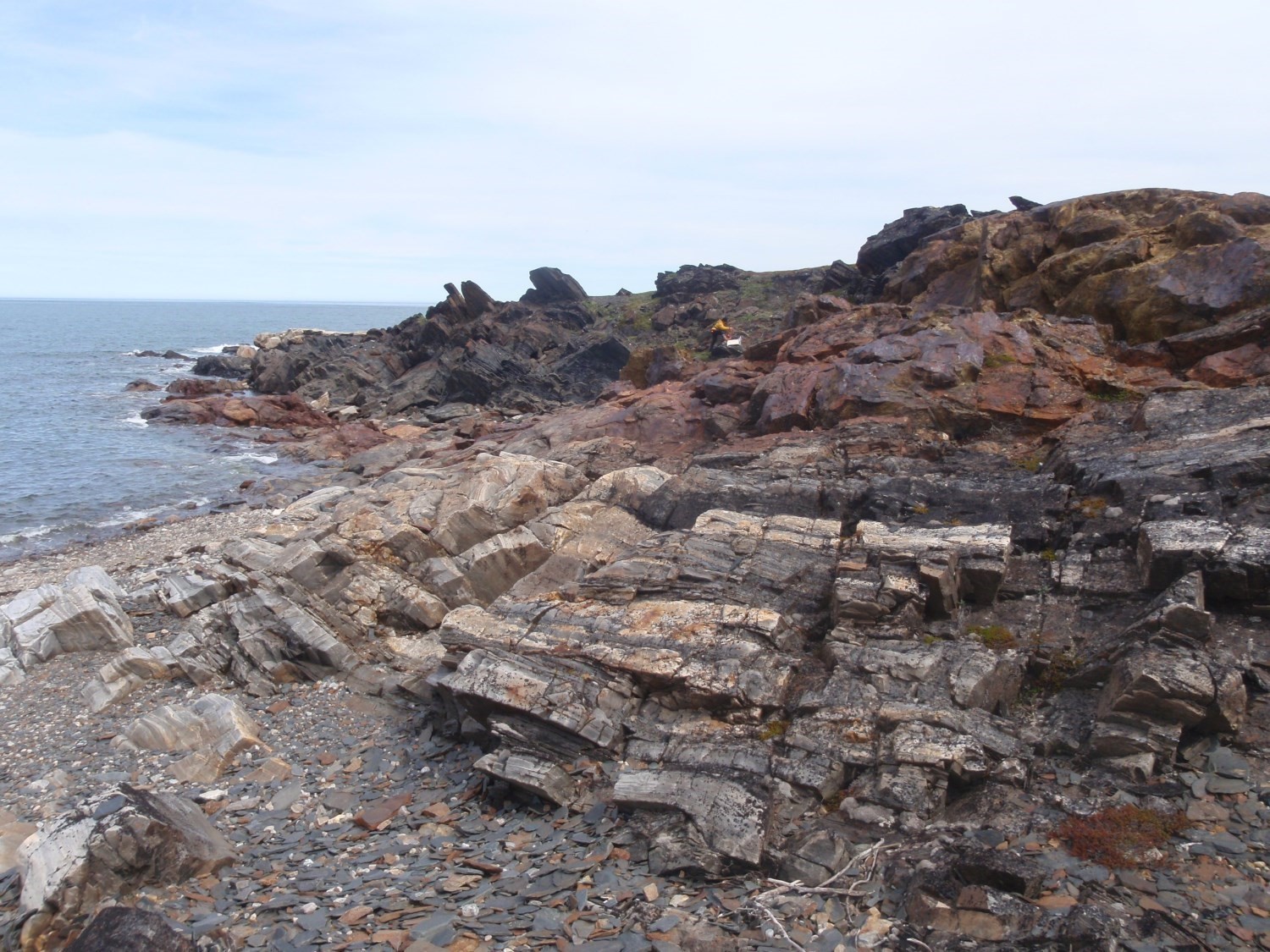 In the Falcoz Shear Zone (ZCflz), paragneiss displays a well-defined quartz band protomylonitic texture. In outcrop, there are many decimetre- to decametre-wide rusted zones, as well as paragneiss lauerss that have undergone severe surface alterations and where the rock is reduced to sand. In these layers, paragneiss is rich in K-feldspar and contains 5 to 20% graphite. More locally, orthopyroxene is observed in paragneiss. The latter then takes on a brown sugar alteration colour characteristic of orthopyroxene rocks. In these rocks, biotite (2-8%) is dark brown, almost reddish, indicating high temperature biotite. There is also green hornblende (3-7%), garnet (5-15%) and augite (<5%).
In the Falcoz Shear Zone (ZCflz), paragneiss displays a well-defined quartz band protomylonitic texture. In outcrop, there are many decimetre- to decametre-wide rusted zones, as well as paragneiss lauerss that have undergone severe surface alterations and where the rock is reduced to sand. In these layers, paragneiss is rich in K-feldspar and contains 5 to 20% graphite. More locally, orthopyroxene is observed in paragneiss. The latter then takes on a brown sugar alteration colour characteristic of orthopyroxene rocks. In these rocks, biotite (2-8%) is dark brown, almost reddish, indicating high temperature biotite. There is also green hornblende (3-7%), garnet (5-15%) and augite (<5%).
Decimetric to decametric layers of impure quartzite, calc-silicate rocks and amphibolite are interbedded in the pPhb1 paragneiss. Garnetites were also observed on three outcrops in the Koroc River area. Two of them contain diopside and sphene with or without calcite, plagioclase, epidote, magnetite and sulphides. The third outcrop, located in the ZCflz, also contains quartz, apatite, sulphides, red biotite, magnetite, monazite and harrisonite.
Lake Harbour Suite 1a (pPhb1a): Diatexite Derived from Melting of Paragneiss
 In some areas, the more important melting of paragneiss resulted in diatexites assigned to subunit pPhb1a. These diatexites contain 40 to 65% mobilisate in millimetric to centimetric whitish bands. In outcrop, there are numerous zones of leucosome accumulation, as well as enclaves and decimatric to metric layers of preserved paragneiss. Diatexite is heterogranular, grey in altered surface and brownish white in fresh exposure. Its composition is variable due to the unequal distribution of K-feldspar (0-20%) in the rock. It contains 10 to 20% brown to red biotite forming schlierens that mould quartzofeldspathic clusters or zones. Biotite is commonly associated with muscovite flakes and, more locally, sillimanite. The main accessory minerals are garnet (<5%), sphene, hornblende, apatite, zircon, allanite, epidote and graphite.
In some areas, the more important melting of paragneiss resulted in diatexites assigned to subunit pPhb1a. These diatexites contain 40 to 65% mobilisate in millimetric to centimetric whitish bands. In outcrop, there are numerous zones of leucosome accumulation, as well as enclaves and decimatric to metric layers of preserved paragneiss. Diatexite is heterogranular, grey in altered surface and brownish white in fresh exposure. Its composition is variable due to the unequal distribution of K-feldspar (0-20%) in the rock. It contains 10 to 20% brown to red biotite forming schlierens that mould quartzofeldspathic clusters or zones. Biotite is commonly associated with muscovite flakes and, more locally, sillimanite. The main accessory minerals are garnet (<5%), sphene, hornblende, apatite, zircon, allanite, epidote and graphite.
Lake Harbour Suite 1b (pPhb1b): Migmatized Paragneiss
The pPhb1b unit consists of migmatized paragneiss klippes located east of the ZCblm. It is associated with well-defined negative magnetic anomalies on the residual component of the total magnetic field. The pPhb1b unit is also observed in thinner layers, intercalated in the orthogneiss units of the Sukaliuk Complex.
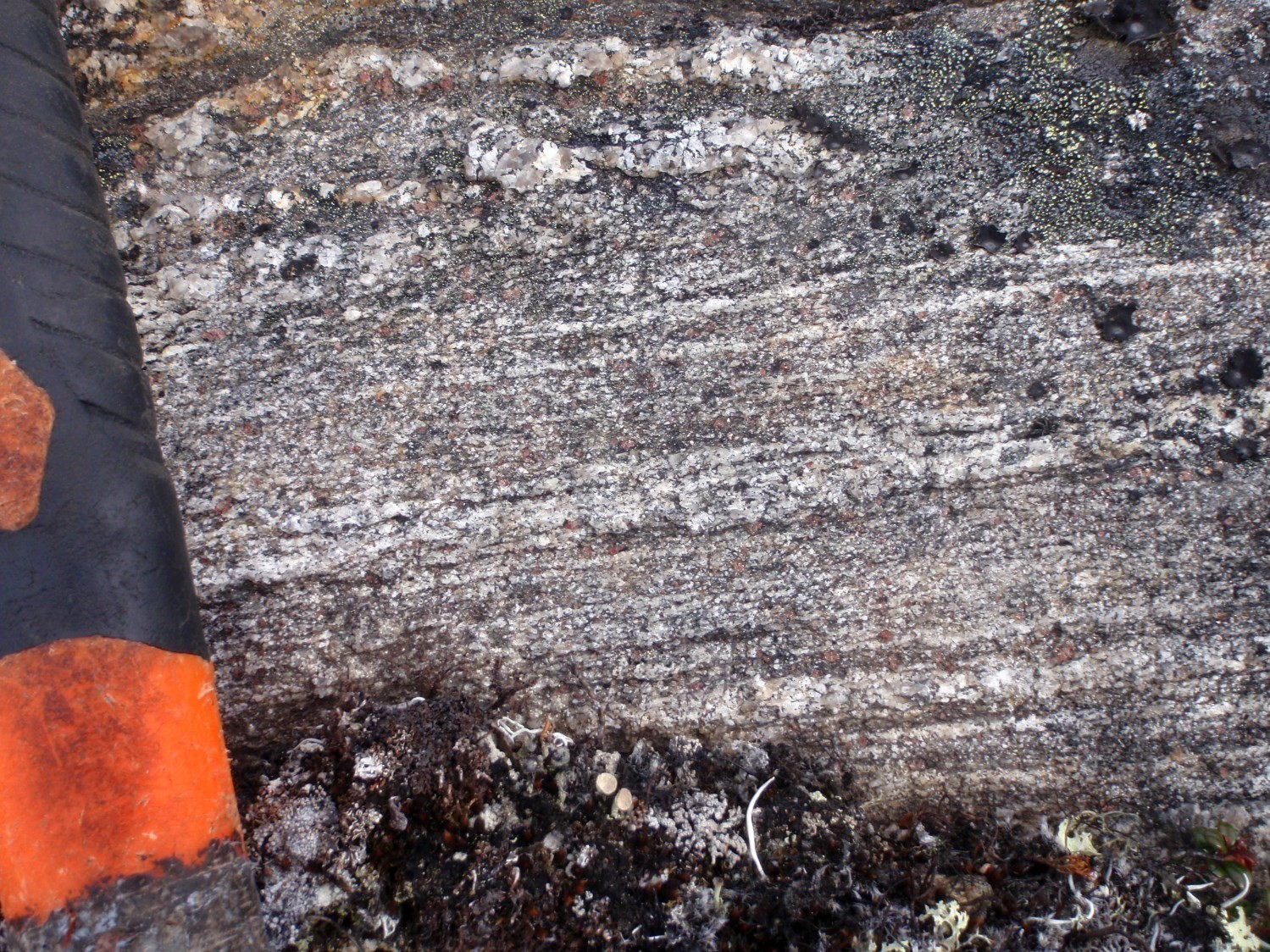 The paragneiss is variably migmatized and contains 0 to 30% of millimetric to centimetric bands of whitish or brown sugar to greenish leucosome, depending on the presence or absence of hypersthene. Quartz (30 to 60%) is systematically recrystallized in lenses or rods and displays a marked undulatory extinction. Staining and thin sections highlight compositional variations in the paragneiss and leucosome, particularly with respect to the proportion of K-feldspar, which varies from 0 to 35% depending on the sample. Decimetric to metric layerls of diatexite indicate more partial melting. Similarly, several thicker leucosome layers are observed in the paragneiss. The metasedimentary rocks have a fine granoblastic microtexture and are well foliated. They contain 2-15% millimeter-sized crystals of dark pink garnet (1-4 mm) and 10-25% dark brown to red biotite sheets. Green hornblende-rich bands, clinopyroxene and orthopyroxene are also observed more locally, the latter being more common in the leucosome. Alternating layers with and without hypersthene, as well as sillimanite- or graphite-rich layers are also observed locally. The main accessory minerals are opaque minerals, apatite, graphite, zircon, serpentine, chlorite, sphene, allanite, carbonates and rutile.
The paragneiss is variably migmatized and contains 0 to 30% of millimetric to centimetric bands of whitish or brown sugar to greenish leucosome, depending on the presence or absence of hypersthene. Quartz (30 to 60%) is systematically recrystallized in lenses or rods and displays a marked undulatory extinction. Staining and thin sections highlight compositional variations in the paragneiss and leucosome, particularly with respect to the proportion of K-feldspar, which varies from 0 to 35% depending on the sample. Decimetric to metric layerls of diatexite indicate more partial melting. Similarly, several thicker leucosome layers are observed in the paragneiss. The metasedimentary rocks have a fine granoblastic microtexture and are well foliated. They contain 2-15% millimeter-sized crystals of dark pink garnet (1-4 mm) and 10-25% dark brown to red biotite sheets. Green hornblende-rich bands, clinopyroxene and orthopyroxene are also observed more locally, the latter being more common in the leucosome. Alternating layers with and without hypersthene, as well as sillimanite- or graphite-rich layers are also observed locally. The main accessory minerals are opaque minerals, apatite, graphite, zircon, serpentine, chlorite, sphene, allanite, carbonates and rutile.
In some areas, particularly in the northern part of the Falcoz Lithotectonic Domain, the paragneiss of unit pPhb1b also contains decimetric to metric layers of clinopyroxene-garnet amphibolite, quartzite, marble, and calc-silicate rocks.
Lake Harbour Suite 2 (pPhb2): Quartzite
Impure quartzite layers contain up to 10% K-feldspar or plagioclase, as well as laminae rich in muscovite, sillimanite or graphite. Sillimanite occurs as flexuous clusters of fine needles. Biotite (<12%), brown to green and with zircon inclusions, garnet (<2%) and tourmaline are also commonly observed. Accessory minerals are apatite, clinopyroxene, zircon, graphite, magnetite and sulphides. In several areas, particularly near ultramafic sills of the Nuvulialuk Suite (pPnuv), quartzite contains pyrite and graphite mineralization (5-25%), disseminated and as laminae.
Lake Harbour Suite 2a (pPhb2a): Impure Quartzite
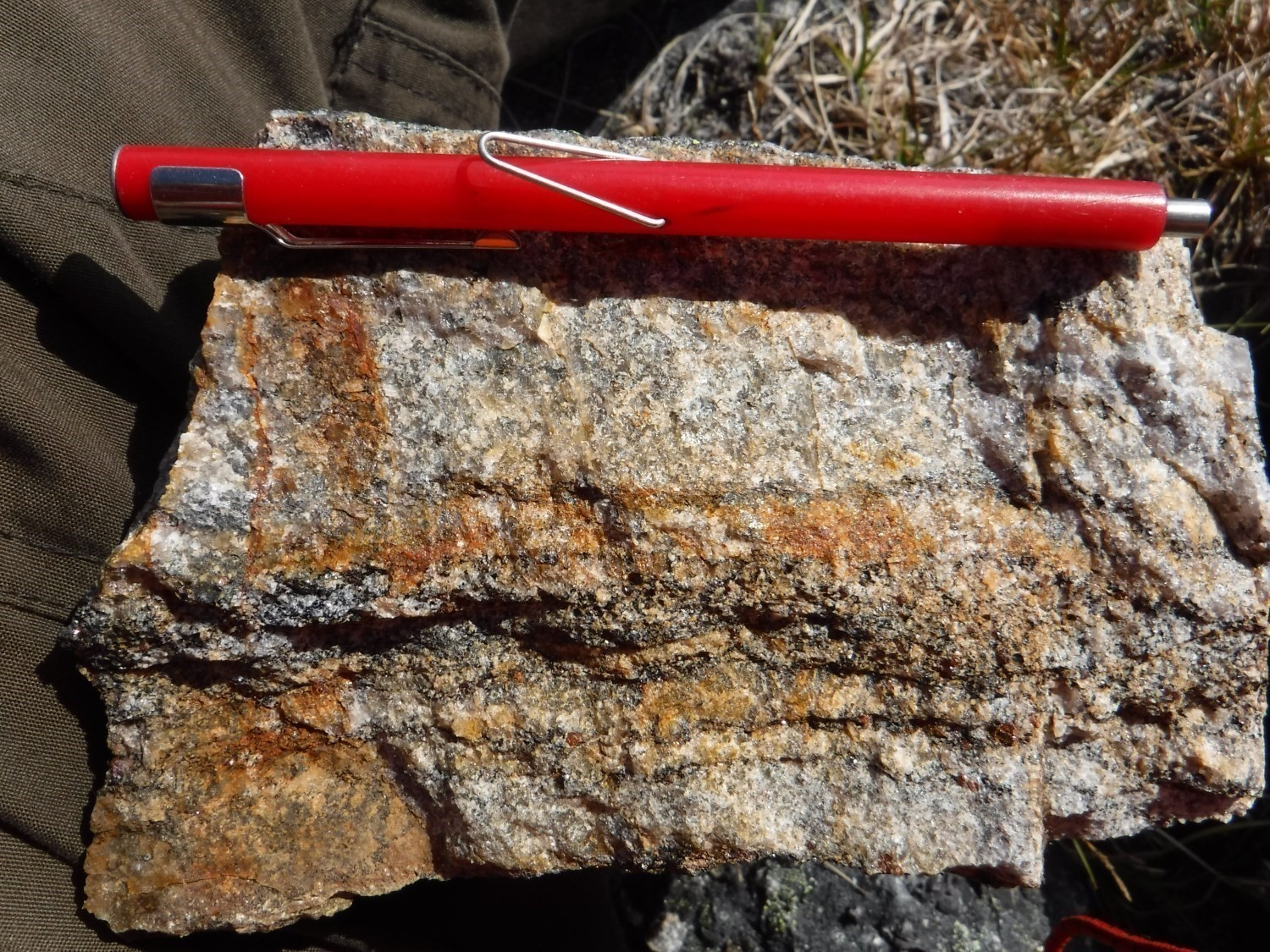 Unit pPhb2a consists of quartzite outcrops located east of the ZCblm. The quartzite is generally impure and forms klippes <1 km wide. It contains >75% quartz, feldspars, biotite, and muscovite. Accessory minerals observed are apatite, tourmaline, zircon, and graphite. Quartzite may also contain sulphides and magnetite. Quartz grains may be indented, lenticular or in bands. Micas in places give a lepidoblastic texture to the quartzite, especially evident in thin section, but which can give the rock a bedded appearance. Quartzite is commonly cut by quartz veins and veinlets.
Unit pPhb2a consists of quartzite outcrops located east of the ZCblm. The quartzite is generally impure and forms klippes <1 km wide. It contains >75% quartz, feldspars, biotite, and muscovite. Accessory minerals observed are apatite, tourmaline, zircon, and graphite. Quartzite may also contain sulphides and magnetite. Quartz grains may be indented, lenticular or in bands. Micas in places give a lepidoblastic texture to the quartzite, especially evident in thin section, but which can give the rock a bedded appearance. Quartzite is commonly cut by quartz veins and veinlets.
Lake Harbour Suite 3 (pPhb3): Calc-silicate Rocks and Marble
Calc-silicate rocks and marbles are commonly located in contact between Archean gneiss and paragneiss. Since many of these contacts are tectonic, it is possible that these lithologies acted as ductile materials that facilitated movement on shear zones. They may also represent alteration zones near NE-SW fault zones. Moreover, these rocks contain millimetric quartz bands, indicating a protomylonitic fabric, and generally form centimetre- to metre-long boudins in the different units of the Lake Harbour Suite. In this case, reaction rims are observed around the boudins.
According to Verpaelst et al. (2000), marble forms thin sequences, usually at the base of the Lake Harbour Suite. Most of it is calcitic, although dolomitic marble is also found. It is generally interbedded between layers of paragneiss or more or less pure quartzite. Marble is medium to coarse grained, heavily deformed and granoblastic. It can be equigranular or heterogranular and it is generally well foliated. During a low temperature deformation episode, mylonitization caused some marbles to reduce their grain size. Minerals observed are carbonates, phlogopite, tremolite, olivine, diopside and scapolite. Olivine is variably altered to serpentine and iddingsite; some crystals are partly replaced by chondrodite. Marble also contains a wide variety of accessory minerals such as sulphides, apatite, graphite, sphene, garnet, epidote, zircon, tourmaline, quartz and feldspar.
Calc-silicate rocks are generally associated with marbles and have roughly the same pattern of occurrence in the field. Their mineralogy is varied and displays alternating composition in bands or millimetric to decimetric clusters. They are fine to medium grained with a light greenish colour. In addition to carbonates, diopside, tremolite, epidote, scapolite, plagioclase, quartz and sphene are the common minerals of these rocks. Hornblende, apatite, olivine, phlogopite, garnet, muscovite, spinelchlorite, zircon and allanite may also be present locally. Olivine is coronitic (clinopyroxene crown) and usually serpentinized.
Lake Harbour Suite 4 (pPhb4): Amphibolite
Amphibolite is interstratified with other units of the Lake Harbour Suite, primarily paragneiss and quartzite. Unit pPhb4 is fine grained or aphanitic, granoblastic, banded and dark grey-green to black. In the Koroc River area (Verpaelst et al., 2000), basalt-derived amphibolite forms massive, pillow or breccia flows. However, it is too deformed for polarities to be determined. Its actual thickness is also difficult to assess due to significant deformation. Amphibolite contains 45 to 65% ferromagnesian minerals, consisting of green hornblende (40-50%), clinopyroxene (2-20%) and brown biotite (2-10%). Quartz (<3%), sphene, sulphides, magnetite, chlorite, apatite, garnet and actinolite are the main accessory minerals. Hornblende is biotitized locally. Epidote appears as a plagioclase and ferromagnesian mineral alteration mineral. Quartz is interstitial or occurs as globules in hornblende. Locally, garnet can account for up to 35% of amphibolite.
Thickness and Distribution
The Lake Harbour Suite covers an area of ~4703 km² in the Falcoz Lithotectonic Domain. The largest sequences occur in the Koroc River area (sheet 24I). The paragneiss of the pPhb1 unit (~2461 km²) forms sequences a few kilometres to nearly 30 km wide east of the ZCblm. Unit pPhn1b (~1492 km²) is the second largest unit and forms sequences up to 10-15 km wide by 30-70 km long, as well as elliptical-shaped bodies 3-4 km wide by 6-10 km long. Quartzite in unit pPhb2 (~457 km²) may also represent sequences >10 km wide. The most prominent calc-silicate rock and marble layers of unit pPhb3 (~114 km²) are in the Keglo Bay (sheet 24P04) and Abrat River (sheet 24P03) areas, where they reach a few kilometres in apparent width. The pPhb1a (~52 km²), pPhb2a (~67 km²) and pPhb4 (~60 km²) units and subunits cover smaller areas.
Dating
On Baffin Island, dating obtained from detrital zircons of the Lake Harbour Suite impose a sediment deposition age younger than 1934 ±2 Ma (Scott and Gauthier, 1996). According to the work of Charette (2016) and Charette et al. (2021), about 10 fractured zircon cores gave heritage ages between 2597 Ma and 2019 Ma (sample taken from outcrop 2013-IL-3008). Finally, analysis of sulphur isotopes from two paragneiss samples also indicates that they are derived from a Proterozoic protolith (Wing et al., 2012).
East of the ZCblm, detrital ages obtained from two samples (outcrops 2013-BC-6150 and 2013-DB-1098) range from 2824 Ma to 1884 Ma (Charette et al., 2021), indicating a slightly younger maximum age of deposition than on Baffin Island. Paleoproterozoic ages of zircons and monazites allow us to place the age of leucosome crystallization between 1825 Ma and 1812 Ma. Lu-Hf ages on garnets by Charette et al. (2021), however, indicate that melting of the metasedimentary rocks began earlier, around 1896 Ma.
|
Unit |
Sample Number |
Isotopic System |
Mineral |
Maximum Deposition Age (Ma) |
Detrital Age (Ma) |
Crystallization Age (Ma) |
(+) |
(-) |
Metamorphic Age (Ma) |
(+) |
(-) |
Reference(s) |
|
pPhb1a |
U-Pb |
Zircon |
|
2690 à 2092 |
1812 |
6 |
6 |
|
Davis et al., 2018 |
|||
|
Monazite |
1825 |
7 |
7 |
|||||||||
|
U-Pb |
Zircon |
1884 |
2690 à 1884 |
1811 |
6 |
6 |
Charette et al., 2021 |
|||||
|
Monazite |
1825 |
7 |
7 |
|||||||||
|
Sm-Nd |
Garnet |
1879 |
44 |
44 |
||||||||
|
Lu-Hf |
1896 |
14 |
14 |
|||||||||
|
U-Pb |
Zircon |
1935 |
2824 à 1935 |
1849 |
9 |
9 |
||||||
|
Monazite |
1859 |
7 |
7 |
|||||||||
|
Sm-Nd |
Garnet |
1783 |
16 |
16 |
||||||||
|
pPhb1 |
U-Pb |
Zircon |
2019 |
2597 à 2019 |
1854 |
5 |
5 |
|||||
|
Monazite |
1838 |
6 |
6 |
|||||||||
|
Sm-Nd |
Garnet |
1851 |
70 |
70 |
||||||||
|
Lu-Hf |
1883 |
26 |
26 |
Stratigraphic Relationship(s)
Metamorphosed volcano-sedimentary rocks of the Lake Harbour Suite unconformably overlie gneissic Archean basement of the Falcoz Lithotectonic Domain. However, the contacts observed today are tectonic in nature and can be obliterated by the partial melting that affected all these rocks in the Paleoproterozoic as well as by the presence of late granite and pegmatite intrusions. Paragneiss and quartzite of the Lake Harbour Suite are cut by mafic and ultramafic sills and dykes of the Nuvulialuk Suite (pPnuv).
Paleontology
Does not apply.
References
Publications available through SIGÉOM Examine
DAVIS, D., LAFRANCE, I., GOUTIER, J., TALLA TAKAM, F., GIGON, J., 2018. Datations U-Pb effectuées dans les provinces de Churchill et du Supérieur effectuées au JGSL en 2013-2014. MERN, Québec; RP 2017-01, 63 pages.
LAFRANCE, I., BANDYAYERA, D., BILODEAU, C., 2015. Géologie de la région du lac Henrietta (SNRC 24H). MRN, Québec; RG 2015-01, 62 pages.
LAFRANCE, I., BANDYAYERA, D., CHARETTE, B., BILODEAU, C., DAVID, J., 2016. Géologie de la région du lac Brisson (SNRC 24A). MERN, Québec; RG 2015-05, 61 pages.
LAFRANCE, I., CHARETTE, B., VANIER, M.-A., 2018. Sud-est de la Province de Churchill, Nunavik, Québec, Canada : synthèse de la géologie. MERN; BG 2018-12, 1 plan.
LAFRANCE, I., VANIER, M.-A., 2022. Domaine lithotectonique de Falcoz, sud-est de la Province de Churchill, Nunavik, Québec, Canada : synthèse de la géologie. MERN; BG 2022-01, 2 plans.
MATHIEU, G., LAFRANCE, I., VANIER, M.-A., 2018. Géologie de la région de Pointe le Droit, sud-est de la Province de Churchill, Nunavik, Québec, Canada. Ministère de l’Énergie et des Ressources naturelles, Québec. BG 2018-07, 4 plans.
SIMARD, M., LAFRANCE, I., HAMMOUCHE, H., LEGOUIX, C., 2013. Géologie de la région de Kuujjuaq et de la Baie d’Ungava (SNRC 24J et 24K). MRN, Québec; RG 2013-04, 60 pages.
VERPAELST, P., BRISEBOIS, D., PERREAULT, S., SHARMA, K.N.M., DAVID, J., 2000. Géologie de la région de la rivière Koroc et d’une partie de la région de Hébron (SNRC 24I et 14L). MRN, Québec; RG 99-08, 62 pages, 10 plans.
WING, B., MOUKHSIL, A., SOLGADI, F., HAMMOUCHE, H., LAFRANCE, I., 2012. Analyses des isotopes de soufre des échantillons recueillis à l’été 2011 par Géologie Québec lors des projets de cartographie géologique des provinces de Grenville et de Churchill. MERN, Québec; MB 2012-08, 4 pages.
Other publications
CHARETTE, B., 2016. Long-lived Anatexis in the Exhumed Middle Crust from the Torngat Orogen and Eastern Core Zone: Constraints from Geochronology, Petrochronology, and Phase Equilibria Modeling. University of Waterloo; thèse de maîtrise, 389 pages. uwspace.uwaterloo.ca/handle/10012/10453
CHARETTE, B., GODET, A., GUILMETTE, C., DAVIS, D.W., VERVOORT, J., KENDALL, B., LAFRANCE, I., BANDYAYERA, D., YAKYMCHUK, C., 2021. Long-lived anatexis in the exhumed middle crust of the Torngat Orogen: Constraints from phase equilibria modeling and garnet, zircon, and monazite geochronology. Lithos; volume 388-389. doi.org/10.1016/j.lithos.2021.106022
DAVISON, W.L., 1959. Lake Harbour, Baffin Island, District of Franklin, Northwest Territories. Geological Survey of Canada; Preliminary Map 29-1958, 1 sheet. doi.org/10.4095/108520
HOFFMAN, P., 1988. United Plates of America, the birth of a Craton: Early Proterozoic assembly and growth of ProtoLaurentia. Annual Reviews of Earth and Planetary Sciences; volume 16, pages 543-603. www.annualreviews.org/doi/abs/10.1146/annurev.ea.16.050188.002551
JACKSON, G.D., TAYLOR, F.C., 1972. Correlation of major Aphebian rock units in the northeastern Canadian Shield. Canadian Journal of Earth Sciences; volume 9, pages 1659-1669. www.nrcresearchpress.com/doi/abs/10.1139/e72-146#.Wgno9_nyhhE
NORTH AMERICAN COMMISSION ON STRATIGRAPHIC NOMENCLATURE (NACSN). 1983. North American Stratigraphic Code. American Association of Petroleum Geologists Bulletin; volume 67, pages 841-875. http://archives.datapages.com/data/bulletns/1982-83/data/pg/0067/0005/0800/0841.htm
NORTH AMERICAN COMMISSION ON STRATIGRAPHIC NOMENCLATURE (NACSN). 2005. North American Stratigraphic Code. American Association of Petroleum Geologists Bulletin; volume 89, pages 1547-1591. doi.org/10.1306/07050504129
SCOTT, D.J., GAUTHIER, G., 1996. Comparison of TIMS (U-Pb) and laser ablation microprobe ICP-MS (Pb) techniques for age determination of detrital zircons from Paleoproterozoic metasedimentary rocks from northeastern Laurentia, Canada, with tectonic implications. Chemical Geology; volume 131, pages 127-142. doi.org/10.1016/0009-2541(96)00030-7
TAYLOR, F.C., 1979. Reconnaissance geology of a part of the Precambian Shield, northeastern Quebec, northern Labrador and Northwest Territories. Geological Survey of Canada; Memoir 393, 99 pages and 19 maps. dx.doi.org/10.4095/124930
Suggested Citation
Ministère de l’Énergie et des Ressources naturelles (MERN). Lake Harbour Suite. Quebec Stratigraphic Lexicon. https://gq.mines.gouv.qc.ca/lexique-stratigraphique/province-de-churchill/groupe-de-lake-harbour_en [accessed on day month year].
Contributors
|
First publication |
Isabelle Lafrance, P.Geo., M.Sc. isabelle.lafrance@mern.gouv.qc.ca (redaction) Mehdi A. Guemache, P.Geo., Ph.D. (coordination); Claude Dion, Eng., M.Sc. (critical review); Simon Auclair, P.Geo., M.Sc. (editing); Céline Dupuis, P.Geo., Ph.D. (English version); Caroline Thorn (HTML editing) |
|||
|
Revision(s) |
Isabelle Lafrance, P.Geo., M.Sc. (redaction) Céline Dupuis, P.Geo., Ph.D. (coordination); Marc-Antoine Vanier, Eng., M.Sc. (critical review); Simon Auclair, P.Geo., M.Sc. (editing); Dominique Richard, GIT, Ph.D. (English version); André Tremblay (HTML editing) |
|||


